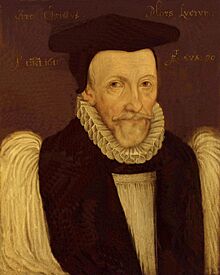Tobias Matthew facts for kids
Quick facts for kids Tobias Matthew |
|
|---|---|
| Archbishop of York | |

official portrait as Archbishop (c. 1608)
|
|
| Enthroned | 1606 |
| Reign ended | 1628 (death) |
| Predecessor | Matthew Hutton |
| Successor | George Montaigne |
| Other posts | Public Orator of Oxford University (1569–1572) President of St John's College, Oxford (1572–1576) Dean of Christ Church (1576–1579) Vice-Chancellor of Oxford University (1579–1583) Dean of Durham (1583–1595) Bishop of Durham (1595–1606) |
| Personal details | |
| Birth name | Tobias Matthew |
| Born | 13 June 1546 Bristol, England |
| Died | 29 March 1628 (aged 81) Cawood, West Riding of Yorkshire, England |
| Buried | York Minster |
| Nationality | English |
| Denomination | Church of England |
| Parents | Sir John Matthew of Ross (1522–1569) Eleanor Crofton of Ludlow (1525–1546) |
| Spouse | Frances Barlow (married 1576; he died 1628) |
| Children | Tobias (1577–1655) Mary (1579–1583) Samuel (1583–1601) Mary Ann (1599–1666) |
| Alma mater | University College, Oxford Christ Church, Oxford |
Tobias Matthew (born June 13, 1546 – died March 29, 1628) was an important Anglican church leader in England. He held many significant roles during his life. These included being the President of St John's College, Oxford, and later the Vice-Chancellor of Oxford University. He also served as the Dean of Durham.
Queen Elizabeth I appointed him to many of these positions. Later, King James I chose him to be the Archbishop of York in 1606. This was a very high position in the Church of England.
Contents
Who was Tobias Matthew?
Tobias Matthew was born in Bristol, England, on June 13, 1546. His father was Sir John Matthew of Ross, and his mother was Eleanor Crofton.
Where did Tobias Matthew study?
Matthew received his education first in Wells, Somerset. After that, he attended two famous colleges at Oxford University: University College and Christ Church, Oxford. He earned his first degree, a Bachelor of Arts (BA), in 1564. Two years later, in 1566, he completed his Master of Arts (MA) degree.
How did Tobias Matthew rise in power?
Tobias Matthew caught the attention of Queen Elizabeth I. This helped him move steadily up in his career. He started as a public orator at Oxford in 1569. This role involved giving official speeches.
What important roles did Matthew hold?
Matthew held many important positions throughout his life.
- In 1572, he became the President of St John's College.
- He then became Dean of Christ Church in 1576.
- From 1579, he served as Vice-Chancellor of Oxford University.
- In 1583, he was appointed Dean of Durham.
- He became Bishop of Durham in 1595.
- Finally, in 1606, he was appointed Archbishop of York. This was one of the most powerful church roles in England.
What did Matthew do as Archbishop?
As Archbishop of York, Matthew worked hard to make sure people followed the rules of the Church of England. He gave many sermons and visited churches often. He wanted everyone to be part of the official church.
Did Matthew have any disagreements?
In 1581, Matthew had a discussion with Edmund Campion, a Jesuit priest. Matthew later published his arguments from this discussion in a book. He also helped resolve issues with a group called the Grindletonians. Their leader, Roger Brearley, was accused of not following church rules. Matthew sent his assistant, Phineas Hodson, to help Brearley make peace with the Church of England.
When did Tobias Matthew die?
In his later years, Tobias Matthew sometimes disagreed with King James I's government. He was excused from attending Parliament in 1625 because he was old and unwell.
Matthew was married to Frances Barlow for over 50 years. She was the daughter of William Barlow, who was also a bishop. Matthew's son, Tobie Matthew, became a member of Parliament. He later converted to Roman Catholicism.
Tobias Matthew passed away on March 29, 1628, at the age of 81. He was buried in the Lady Chapel of York Minster.
What happened to Matthew's possessions?
Matthew left his money and belongings to his wife, Frances. He owned about 600 books, which were very valuable at the time. Frances later gave all these books to York Minster. These books became the start of the library there. Frances died the following year and was buried next to her husband in York Minster.

